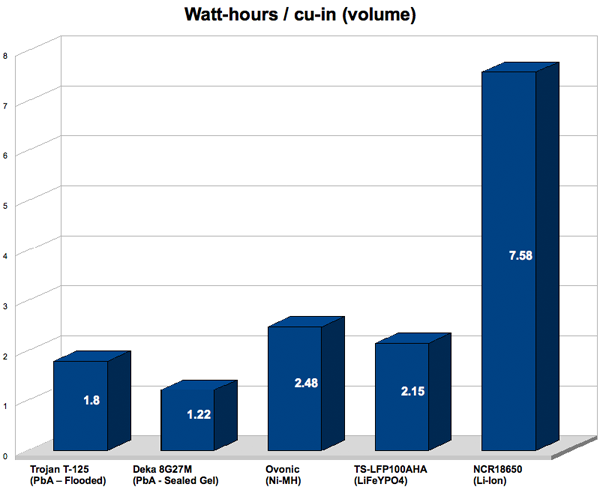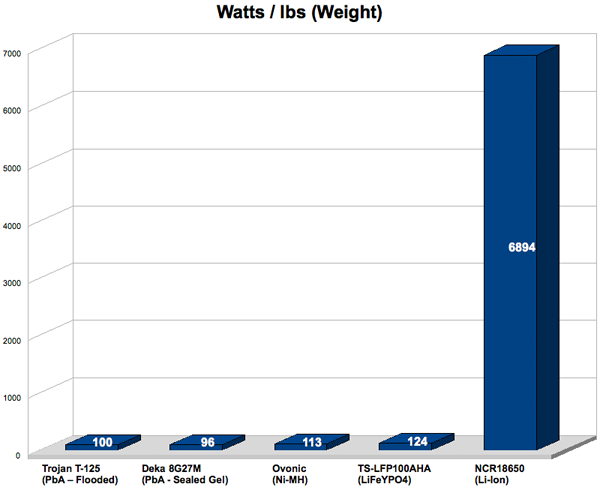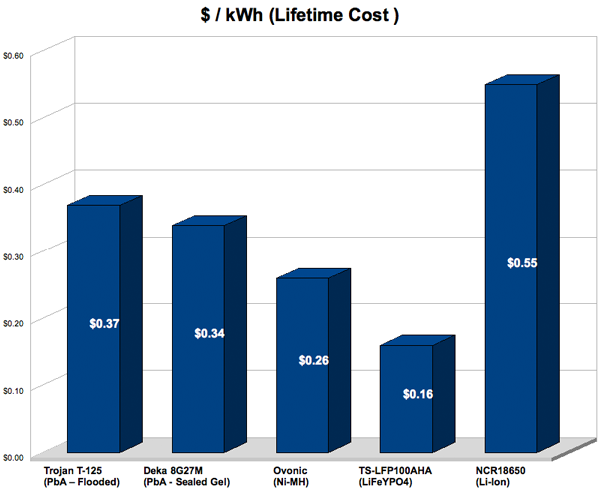The following charts focus on a selection of 5 different electric car batteries from the Battery List...
- Trojan T-125, flooded lead acid, golf cart batteries. Very popular in DC electric vehicle conversions.
- Deka Dominator 8G27M, sealed lead acid, marine batteries. Used in AC electric vehicle conversions, including my Saturn. The GM Solectria traction pack used 13 these.
- Ovonic 9500, Nickel-metal hydride. This is the battery used in the GM's legendary EV-1. While this model of battery is no longer available, similar NiMH batteries are still manufactured by Cobasys.
- ThunderSky, LiFeYPO4. One of the most popular lithium based batteries for EV conversions.
- Panasonic NCR18650, Lithium ion, computer battery. Used in the Tesla Roadster and the BMW Mini-E.

Watt-hours per dollar. Since the budget is usually the first considerations, this chart comes first. How many watt-hours are you getting for your dollar? The total watt-hour energy of the battery (voltage x amp hours) is divided by the real cost of the battery in US dollars. The Trojan battery comes out on top at 8.5 watt-hours per dollar, the lithium batteries are more expensive.

Watt-hours per pound One major consideration in designing a battery pack is the weight. This chart shows the total energy of the battery divided by the weight of the battery. The Tesla cell type batteries are the winner at 105 watt-hours/pound and the clear loser is the Deka Dominator.

Watt-hours per cubic inch. This chart shows the total energy of the battery divided by the volume of the battery. Again, the Tesla battery comes out on top at 7.58 watt-hours per cubic inch and the Deka Dominator loses.

Watts (max) per pound. This chart shows the maximum continuous power the battery is rated at divided by its weight. At the battery list demonstrates, cell type batteries do much better in this category than the others.

Finally, the total lifetime cost of the battery. The cycle life of the battery is used to determine the total kilowatt-hours the battery will deliver over its lifetime and divides that by the original cost of the battery. Here the ThunderSky wins at $0.16/kilowatt-hour -- half the cost of lead acid.
Disclaimer: I have tried to compile this information as accurately as possible. Since I am selling nothing, I have nothing to gain by skewing these results in any direction. My main reason for doing this study was to determine the best possible battery for my electric vehicle conversion project. Initially, I used the Deka Dominator sealed gel batteries which faired quite poorly in these comparisons.
If you have any questions or comments about this page, please feel free to send me an email.